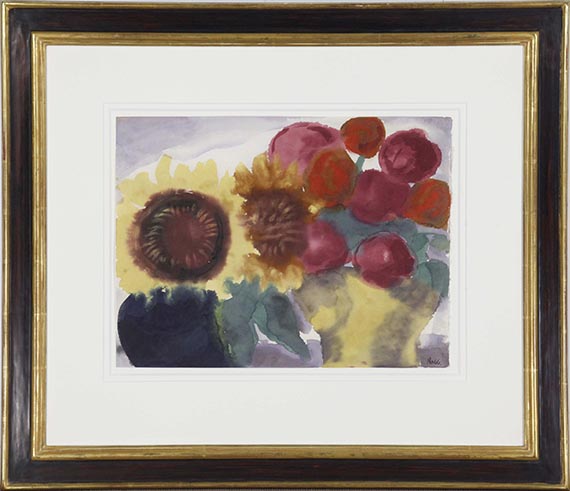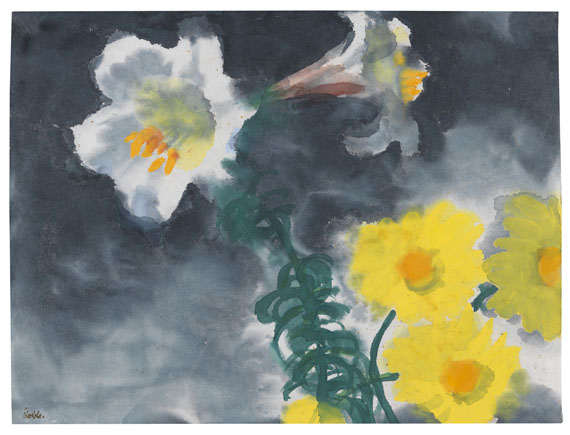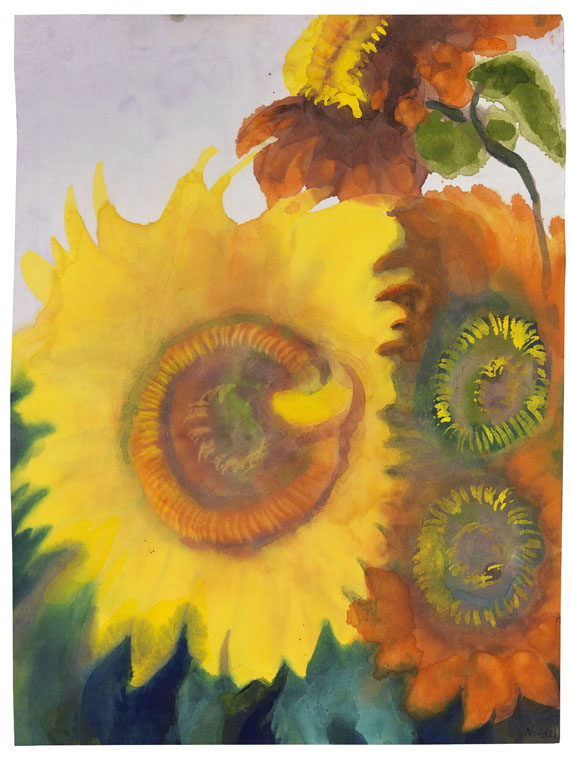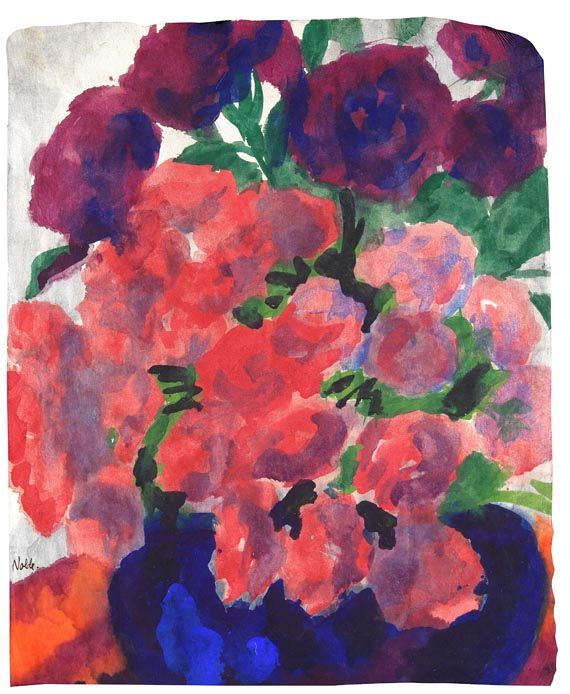262
Emil Nolde
Sonnenblumen mit Pfingstrosen, Um 1930.
Watercolor
Post auction sale: € 60,000 / $ 70,800
Sonnenblumen mit Pfingstrosen. Um 1930.
Watercolor.
Signed in the lower right. On Japan paper. 35.7 x 47.3 cm (14 x 18.6 in), the full sheet.
[MH].
• Iconic Expressionism: Flower arrangements are among the most sought-after subjects in the artist's oeuvre.
• For Nolde, flowers have a soul, particularly sunflowers with their human physiognomy, which he sees as vehicles for powerful expression.
• Nolde was a master of the watercolor technique: works from the 1930s reveal his fully developed style with spontaneous brushwork.
Accompanied by a photo certificate of authenticity issued by Prof. Dr. Manfred Reuther on October 3, 2014.
The Academic Advisory Board of the Seebüll Ada and Emil Nolde Foundation has confirmed the inclusion of the work in a future catalogue raisonné of watercolors and drawings by Emil Nolde (1867–1956) (reg. no. 3432).
PROVENANCE: From a collection in North Rhine-Westphalia.
“All the flowers blossomed for her delight and mine, and the sun was shining brightly over the garden.”
Emil Nolde, quoted from: Manfred Reuter, “Grüße von unserem schönen Garten” – Emil Noldes Gärten und seine Blumenbilder, in: Manfred Reuter, Emil Nolde. Mein Garten voller Blumen , Seebüll 2010, p. 23.
Watercolor.
Signed in the lower right. On Japan paper. 35.7 x 47.3 cm (14 x 18.6 in), the full sheet.
[MH].
• Iconic Expressionism: Flower arrangements are among the most sought-after subjects in the artist's oeuvre.
• For Nolde, flowers have a soul, particularly sunflowers with their human physiognomy, which he sees as vehicles for powerful expression.
• Nolde was a master of the watercolor technique: works from the 1930s reveal his fully developed style with spontaneous brushwork.
Accompanied by a photo certificate of authenticity issued by Prof. Dr. Manfred Reuther on October 3, 2014.
The Academic Advisory Board of the Seebüll Ada and Emil Nolde Foundation has confirmed the inclusion of the work in a future catalogue raisonné of watercolors and drawings by Emil Nolde (1867–1956) (reg. no. 3432).
PROVENANCE: From a collection in North Rhine-Westphalia.
“All the flowers blossomed for her delight and mine, and the sun was shining brightly over the garden.”
Emil Nolde, quoted from: Manfred Reuter, “Grüße von unserem schönen Garten” – Emil Noldes Gärten und seine Blumenbilder, in: Manfred Reuter, Emil Nolde. Mein Garten voller Blumen , Seebüll 2010, p. 23.
262
Emil Nolde
Sonnenblumen mit Pfingstrosen, Um 1930.
Watercolor
Post auction sale: € 60,000 / $ 70,800
Buyer's premium, taxation and resale right compensation for Emil Nolde "Sonnenblumen mit Pfingstrosen"
This lot can be purchased subject to differential or regular taxation, artist‘s resale right compensation is due.
Differential taxation:
Hammer price up to 800,000 €: herefrom 32 % premium.
The share of the hammer price exceeding 800,000 € is subject to a premium of 27 % and is added to the premium of the share of the hammer price up to 800,000 €.
The share of the hammer price exceeding 4,000,000 € is subject to a premium of 22 % and is added to the premium of the share of the hammer price up to 4,000,000 €.
The buyer's premium contains VAT, however, it is not shown.
Regular taxation:
Hammer price up to 800,000 €: herefrom 27 % premium.
The share of the hammer price exceeding 800,000 € is subject to a premium of 21% and is added to the premium of the share of the hammer price up to 800,000 €.
The share of the hammer price exceeding 4,000,000 € is subject to a premium of 15% and is added to the premium of the share of the hammer price up to 4,000,000 €.
The statutory VAT of currently 7 % is levied to the sum of hammer price and premium.
We kindly ask you to notify us before invoicing if you wish to be subject to regular taxation.
Calculation of artist‘s resale right compensation:
For works by living artists, or by artists who died less than 70 years ago, a artist‘s resale right compensation is levied in accordance with Section 26 UrhG:
4 % of hammer price from 400.00 euros up to 50,000 euros,
another 3 % of the hammer price from 50,000.01 to 200,000 euros,
another 1 % for the part of the sales proceeds from 200,000.01 to 350,000 euros,
another 0.5 % for the part of the sale proceeds from 350,000.01 to 500,000 euros and
another 0.25 % of the hammer price over 500,000 euros.
The maximum total of the resale right fee is EUR 12,500.
The artist‘s resale right compensation is VAT-exempt.
Differential taxation:
Hammer price up to 800,000 €: herefrom 32 % premium.
The share of the hammer price exceeding 800,000 € is subject to a premium of 27 % and is added to the premium of the share of the hammer price up to 800,000 €.
The share of the hammer price exceeding 4,000,000 € is subject to a premium of 22 % and is added to the premium of the share of the hammer price up to 4,000,000 €.
The buyer's premium contains VAT, however, it is not shown.
Regular taxation:
Hammer price up to 800,000 €: herefrom 27 % premium.
The share of the hammer price exceeding 800,000 € is subject to a premium of 21% and is added to the premium of the share of the hammer price up to 800,000 €.
The share of the hammer price exceeding 4,000,000 € is subject to a premium of 15% and is added to the premium of the share of the hammer price up to 4,000,000 €.
The statutory VAT of currently 7 % is levied to the sum of hammer price and premium.
We kindly ask you to notify us before invoicing if you wish to be subject to regular taxation.
Calculation of artist‘s resale right compensation:
For works by living artists, or by artists who died less than 70 years ago, a artist‘s resale right compensation is levied in accordance with Section 26 UrhG:
4 % of hammer price from 400.00 euros up to 50,000 euros,
another 3 % of the hammer price from 50,000.01 to 200,000 euros,
another 1 % for the part of the sales proceeds from 200,000.01 to 350,000 euros,
another 0.5 % for the part of the sale proceeds from 350,000.01 to 500,000 euros and
another 0.25 % of the hammer price over 500,000 euros.
The maximum total of the resale right fee is EUR 12,500.
The artist‘s resale right compensation is VAT-exempt.
Headquarters
Joseph-Wild-Str. 18
81829 Munich
Phone: +49 89 55 244-0
Fax: +49 89 55 244-177
info@kettererkunst.de
Louisa von Saucken / Undine Schleifer
Holstenwall 5
20355 Hamburg
Phone: +49 40 37 49 61-0
Fax: +49 40 37 49 61-66
infohamburg@kettererkunst.de
Dr. Simone Wiechers / Nane Schlage
Fasanenstr. 70
10719 Berlin
Phone: +49 30 88 67 53-63
Fax: +49 30 88 67 56-43
infoberlin@kettererkunst.de
Cordula Lichtenberg
Gertrudenstraße 24-28
50667 Cologne
Phone: +49 221 510 908-15
infokoeln@kettererkunst.de
Hessen
Rhineland-Palatinate
Miriam Heß
Phone: +49 62 21 58 80-038
Fax: +49 62 21 58 80-595
infoheidelberg@kettererkunst.de
We will inform you in time.




 Lot 262
Lot 262 




